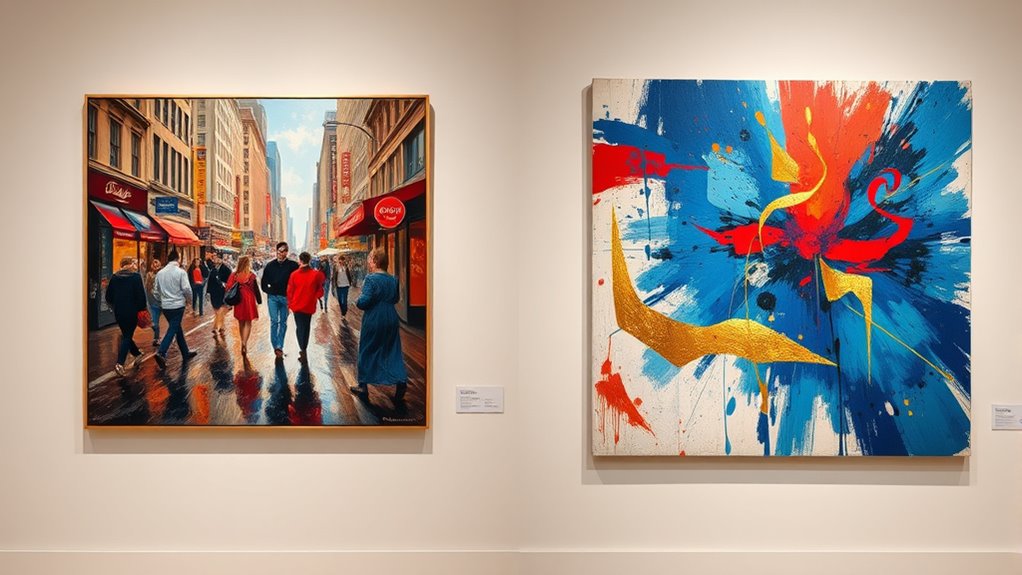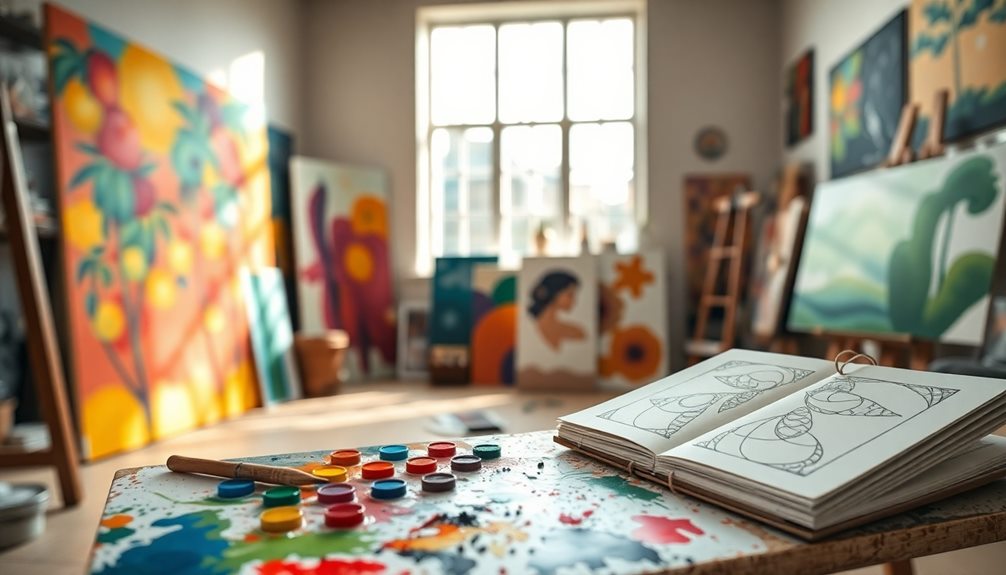To appreciate the shift from realism to abstraction, start by looking at how artists use techniques and cultural influences to express ideas and emotions. Notice how styles change from detailed, realistic portrayals to more experimental forms that focus on color, shape, or emotion. Recognize the innovation behind each approach and consider what society or feelings inspired those choices. By exploring these connections, you’ll discover deeper insight into how art evolves—keep exploring to learn more.
Key Takeaways
- Understand the historical and cultural context behind each art style to appreciate its unique message and purpose.
- Observe the techniques used, such as realism, fragmentation, or bold color, to recognize stylistic innovations and skill.
- Notice how artistic focus shifts from detailed representation to emotional expression or abstract forms.
- Compare styles across periods to see how societal influences shape artistic methods and themes.
- Engage actively with artworks by reflecting on how technique and cultural background influence your emotional and intellectual response.

Art styles have evolved over centuries, shaping how you interpret and appreciate visual works. This evolution isn’t random; it’s driven by a combination of techniques development and cultural influences that reflect the times, societies, and philosophies behind each piece. As you explore different art styles, you’ll notice how artists experiment with techniques, pushing boundaries to express new ideas or emotions. For instance, during the Renaissance, mastery of perspective and realistic detail defined the era, emphasizing lifelike representations rooted in a renewed interest in humanism and classical learning. Fast forward to Impressionism, where artists broke away from precise realism to focus on capturing fleeting moments and the effects of light, illustrating how techniques evolved to prioritize perception over accuracy. These shifts show how technique development aligns with cultural influences—changing values, technological advances, and social contexts all shape artistic expression. Recognizing the importance of technique development helps you see beyond the surface, appreciating the skill and innovation behind each style. When you look at a Cubist painting, for example, you can appreciate how artists fragmented forms and used geometric shapes to challenge traditional perspectives, influenced by modernist ideas and a desire to depict multiple viewpoints simultaneously. In contrast, Abstract art abandons recognizable subjects altogether, emphasizing color, form, and emotion. Here, you see how cultural influences, such as a move towards individualism or spiritual exploration, inspire artists to strip away realism and focus on pure expression. Additionally, understanding artistic innovation allows you to trace how new materials and tools have enabled artists to experiment with different techniques, further enriching the diversity of styles. Moreover, the development of new art techniques often correlates with technological advances that expand creative possibilities for artists. Appreciating these differences means acknowledging that each style responds to its cultural backdrop—be it political upheaval, technological progress, or philosophical shifts. Recognizing how cultural influences impact artistic choices enables you to better interpret the messages and emotions conveyed through various styles. As you explore art, recognizing the techniques development allows you to follow the lineage of artistic ideas and innovations. It helps you see how artists adapt and reinvent their craft to reflect their environment’s cultural influences. For example, the bold lines and vivid colors of Fauvism reflect a desire to evoke emotion through raw, unrestrained expression, influenced by a post-World War I desire for liberation and new beginnings. When you compare styles across periods, you gain insight into how cultural influences shape not just the content but also the methods artists choose to communicate their messages. This understanding deepens your appreciation, making viewing art an active, engaging process rather than a passive observation. By recognizing the interplay of techniques development and cultural influences, you connect more meaningfully with each piece, appreciating how art is a dynamic dialogue between creator and society that continues to evolve today.
Frequently Asked Questions
How Do I Identify an Artwork’s Primary Style?
To identify an artwork’s primary style, start with technique analysis—notice the brushwork, use of color, and texture. Then, consider the historical context to understand what influences shaped its look. For example, realism emphasizes detailed, true-to-life depictions, while abstraction simplifies forms. Combining these insights helps you recognize the style, whether it’s impressionism, cubism, or another, and appreciate the artist’s intent behind their technique.
Can an Artwork Belong to Multiple Styles Simultaneously?
You might wonder if an artwork can belong to multiple styles at once. Yes, it can, through style fusion or genre blending. Artists often combine elements from different styles to create unique pieces, making it challenging to categorize. When you see a work that mixes realism with abstract shapes or traditional with modern techniques, recognize how these combinations reflect the artist’s creative exploration and expand the boundaries of style.
How Do Cultural Contexts Influence Art Style Preferences?
You can see that cultural contexts, like cultural symbolism and regional influences, shape your art style preferences. They influence what themes, colors, and techniques resonate with you, reflecting your background and surroundings. When you explore different artworks, notice how cultural stories and traditions inform their style. Embracing these influences helps you appreciate diverse art styles, understanding that your environment plays a key role in shaping your aesthetic tastes and perceptions.
Are There Specific Techniques Unique to Each Style?
You might think all art shares the same techniques, but style variation reveals unique methods. For realism, you focus on detailed brushwork and perspective, while abstraction uses bold colors and simplified forms. Technique differentiation highlights how each style emphasizes different aspects, making them distinct. Embrace these differences to deepen your appreciation, recognizing that artists intentionally choose methods that best express their vision, creating a rich tapestry of artistic expression.
How Can I Develop My Own Taste in Diverse Art Styles?
To develop your own taste in diverse art styles, explore various techniques and observe how they evolve across different periods. Pay attention to what resonates with you emotionally and intellectually, allowing your personal preferences to guide your appreciation. Visit galleries, read about art history, and experiment with creating your own work. Over time, this active engagement helps you recognize which styles and techniques truly speak to you.
Conclusion
As you explore these diverse art styles, remember they’re like different seasons—each offering its own beauty and mood. Whether you’re drawn to the crisp clarity of realism or the wild freedom of abstraction, let your heart be the compass. Embrace the journey as a voyage through a colorful landscape, where every brushstroke and form reveals a piece of the artist’s soul. In appreciating art’s variety, you open a world where imagination and reality dance in harmony.









